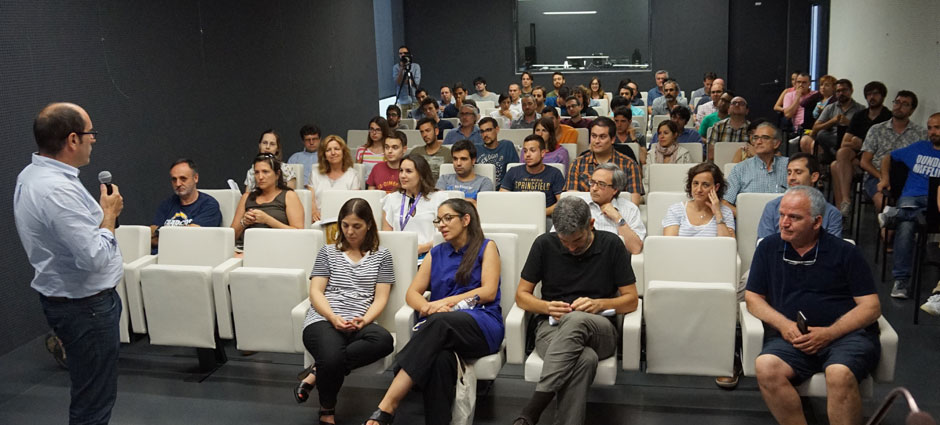Earlier this month was the ICN2’s third Severo Ochoa Scientific Workshop, an event that brought together researchers from all career stages and all of the institute’s research groups to share progress in their respective fields of study. We were also joined by top influencers in innovation and technology transfer in Spain and beyond.

Monday 12 and Tuesday 13 June were two very special days here at the ICN2: they were an opportunity for researchers working on different lines funded under the institute’s Severo Ochoa programme to come together and share their key findings so far. With five sessions devoted to presenting the science, plus multiple opportunities for poster presentations, the event was the embodiment of the interdisciplinary and collaborative nature of life at the institute.
The workshop was opened with a presentation by ICN2 Director Prof. Pablo Ordejón, in which he presented the main goals and projects carried out as part of the institute’s first Severo Ochoa programme. The full programme of this third Severo Ochoa Scientific Workshop can be consulted here.
The first day of the workshop also included a round table discussion, chaired by ICN2 Business Development Officer, Nadia Pons, and headed up by Montserrat Vendrell, founder of Alta Life Sciences and former director of both BIST and BIOCAT. With a background in biomedical research and innovation management, her core message was that, although without scientific excellence like that achieved at the ICN2 there can be nothing else, it is but the start of a cycle that has to include innovation and technology transfer.
Also participating in the debate were Pablo Cironi, director of knowledge and technology transfer at the Centre de Regulacó Genòmica, Xavier Obradors, director of the Institut de Ciència de Materials de Barcelona, and Katerina Zalamova, CEO of Crea·Idea·Lab. (A video of this round table discussion will be available soon.)
Day one was brought to a close with an elevator pitch session where a total of five doctoral and postdoc researchers competed for the chance to receive training from investment professionals on how to spark the interest of potential investors. Presenting to a panel made up of the above round table participants, the pitches outlined the commercial opportunities of Severo Ochoa research lines in graphene, medical devices, solar cells and nanofabrication. Although our congratulations go to all of the candidates for the work that went into crafting their five-minute presentations, the victors were Achille Francone, Daniel Quesada and Ramón García.
The second day kicked off with more scientific sessions, and plenty of coffee breaks and opportunities to network and present the many posters, which lined the hallways of the institute for the duration of the workshop.
Before breaking for lunch Dr. Antoni Homs presented the features and set-up of the new life sciences laboratory facilities expected to be up-and-running by the beginning of autumn. This biosafety level 2+ (BSL2+) laboratory is intended to bridge the gap between device creation and their use in non-specialised external facilities like hospitals. It will also boost the ICN2’s capacity for collaboration with neighbouring research centres.
Tuesday afternoon was kicked off with a presentation by Xavi Martí, co-owner of IGSresearch and an avid speaker on bridging the gap between research and business. Adding a new dimension to the discussion on the career paths available to the professional scientist, Neus Bastús, senior researcher in the ICN2 Inorganic Nanoparticles Group, shared details of her international research career and of opportunities she was presented with, fought for and turned down along the way. (These talks were also recorded, and will be uploaded to our Youtube channel soon.)
As part of the same session, ICN2 People Development Officer Julio Gómez presented the ICN2 PhD Programme that will provide doctoral researchers training in transferable skills like scientific writing, communication skills, ethics, and innovation and entrepreneurship. It has been devised as a means of adding value to the time spent at the institute as a first-stage researcher, as well as to attract and retain talent.
Finally, the event was brought to a close by Prof. Pablo Ordejón in the form of an awards ceremony, not only for the three Best Elevator Pitches already mentioned, but also for the three Best Posters: our congratulations go to Andrea P. Bonaccini, Blanca Chocarro and Rocío Rodríguez, who each won €1200 to go towards travel expenses for an international conference of their choosing. Their poster presentations will also be available for viewing over the coming weeks.
In summary the workshop yet again proved an excellent forum for sharing the knowledge generated through the ICN2 Severo Ochoa programme, and for strengthening the bonds among the ICN2 researcher community. It was a very intense, though thoroughly enjoyable celebration of the advances made in basic and applied nanoscience at the institute over the past year, all set against a backdrop of togetherness and genuine mutual interest and support.
Read more about the ICN2 Severo Ochoa research programme.

